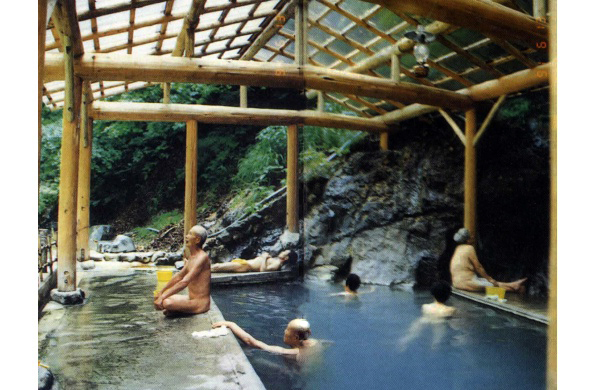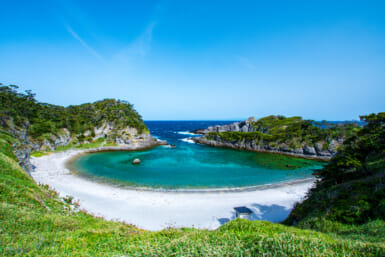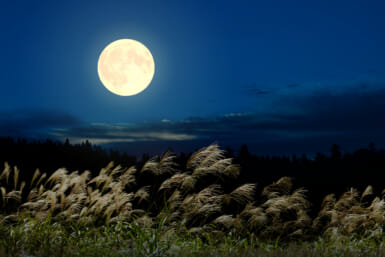by Jeff Manning
It is, indeed, a fact of life that through the years, nothing remains exactly the same. Everything changes for better or worse, depending upon our perspective. The family car replaces the family horse-and-buggy, or the old farmhouse and the land it sits upon becomes the site for a luxurious new shopping mall. Some people would call that sad or inevitable, while others would call it “progress.”
And so it is with the traditional Japanese hotspring (onsen), especially those near Tokyo.
Case in point: Odaru Onsen on the Izu Peninsula in Shizuoka Prefecture. Bathing suits are not quite what we purists would call traditional hotspring attire and not exactly what I’d expected when I arrived. But I’m getting ahead of myself, so let’s start from the beginning.
Odaru Onsen is nestled among some of the most picturesque scenery in Japan. The characters that read odaru mean “large waterfall” in Japanese, and allude to the majestic “centerpiece” at Odaru, the thundering white waterfall that you can see from the main rotenburo (open-air baths) along the river.
In fact, there seem to be rivers and waterfalls everywhere. Water even seeps and trickles out of the very hills themselves! And there are several hiking trails you can take to explore this water wonderland.
One trail in particular winds its way along the river, giving you a grand view of a group of seven famous waterfalls known as “Nandaru.” Each one is unique and beautiful in its own way and the hike isn’t very long or difficult, so the whole family can enjoy it. The scenery is breath-taking, not just because of its beauty, but also because the cold spray from some of the falls can literally take your breath away.
There’s an abundance of hot water, also. In the hotspring area itself, there are numerous rotenburo to choose from. Some are located along the river with a view of the marvelous aforementioned waterfall and many more are tucked away in the lush greenery on the hillside. All are in clean, well-kept, natural settings.
For a change of pace, you can try out the old-fashioned kamaburo, iron pot baths. There are seven of these, all in a row, each named for one of the seven waterfalls along the hiking trail.
There are even two cave baths. One is 15 to 20 meters back into the solid rock; the other contains a fine, upstanding fertility symbol. With all these to choose from, you can literally spend an entire day trying each one out. It’s an onsen lover’s dream…except for the bathing suit.
I have to admit that I was more than a little surprised and dismayed to find out that rental swimwear is available for ¥500. You see, I’ve always enjoyed Japanese onsen for what they are—a quiet, back-to-nature paradise, and especially for what they are not— a water park. (And, as if to emphasize the generation gap, there were those older die-hards who refused to wear anything except a smile, but we were in the minority.) You won’t find many hotspring purists here.
On the other hand, if you are one of those shy, completely westernized type of people who wouldn’t dream of bathing with anyone (of either sex), this might be just what the cross-cultural doctor ordered: a chance to enjoy a totally Japanese experience without the fear of sticking out, as it were. Just take your bathing suit and pretend you’re in a prehistoric swimming pool. It would be a fun place to take a family, too, because kids will love the “Swiss Family Robinson Goes to Yellowstone” atmosphere.
As for the adults, the soothing, hot mineral (sodium chloride) water should be all you need to feel young and invigorated. (Now, I wouldn’t recommend this for everyone, but I know of one crazy fool—me— who, after soaking for a while, felt so good he even took a dip in the ice-cold river a couple of times!)
Amagiso is the main place to stay at Odaru Onsen, as well as being the owners of the hotspring baths along the river. If you stay at Amagiso, you don’t have to pay the entrance fee (¥1,000) at the gate leading to the various pools. Overnight accommodations there start at around ¥18,000 which includes two meals.
A more economical place to stay would be the minshuku Kajiya or Urushiya. The latter has a great little 24-hour rotenburo of its own and you can still use the Amagiso baths by paying the ¥1,000 fee. The service isn’t quite as good, but prices here start around ¥8,000 a night, including dinner and breakfast. The meals consist of delicious Japanese staples such as grilled fish, rice and mountain-grown vegetables. But if these are not your cup o’ tea, then there are several restaurants around with something on the menu you’re bound to like.
The easiest way to get to Odaru Onsen is to take the Tokaido Line Odoriko train that leaves Tokyo Station once an hour on the average, and ride it all the way to Ka wazu Station—about two-and-a-half to three hours, depending on how many stops in between. You can also take the Tokaido Shinkansen and transfer at Atami to the Izu Kyuko Line. Once you get to Kawazu, take the Shunzeji-yuki bus and get off at Odaru Iriguchi, the entrance to Odaru hotsprings. The buses run every 45 minutes or so.









